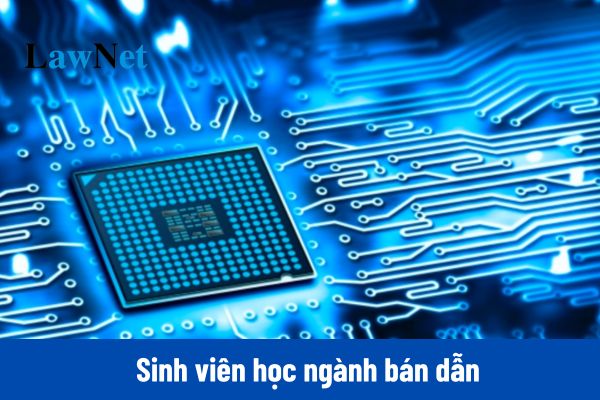Proposal for tuition reduction and exemption for students studying in the semiconductor sector in Vietnam in 2025
Proposal for tuition reduction and exemption for students studying in the semiconductor sector in Vietnam in 2025
Currently, the Ministry of Education and Training of Vietnam is researching and proposing amendments and supplements to the tuition reduction and exemption policies for students stuying programs related to the semiconductor industry.
The Ministry of Education and Training of Vietnam issued Plan 1758/KH-BGDDT in 2024 to implement Decision 1018/QD-TTg in 2024, which approves the "Strategy for Developing Vietnam's Semiconductor Industry by 2030 with a Vision to 2050" and Decision 1017/QD-TTg in 2024, which approves the "Program for Developing Human Resources for the Semiconductor Industry by 2030, with Directions to 2050."
In the year 2025, the Ministry of Education and Training of Vietnam will review, research, and propose amendments and supplements to the policies on tuition reductions, exemptions, and scholarships for students in programs related to the semiconductor industry, both domestically and internationally. Based on subsection c of clause 1, Section 3 of Decision 1017/QD-TTg in 2024:
TASKS AND SOLUTIONS
- Group of tasks and solutions for researching, developing, and perfecting specific mechanisms and policies.
...a) Research, develop specific mechanisms and policies to foster collaboration among the State, educational institutions, and enterprises with several policy directions, including:
- Simplifying administrative procedures, providing investment, financial, accounting, and tax incentives to facilitate investment, support, funding for training, research and development, technology commercialization, technology incubation, and enterprises to develop human resources for the semiconductor industry at research institutes, innovation centers, higher education institutions, and training support facilities;
- Building an effective cooperation model among the State, educational institutions, and enterprises, clearly defining the benefits and responsibilities in human resource training and development;
- Developing a public-private partnership model to integrate state budget resources and private sector capital, both domestic and international. Clarifying the operating mechanism of shared national-level semiconductor laboratories as public assets; creating favorable mechanisms to encourage the private sector to participate in management cooperation, maximizing the creativity and dynamism of the private sector in infrastructure sharing and financial management of public asset use;
b) Research, develop mechanisms and policies to attract domestic talent, overseas Vietnamese, and international experts in the semiconductor and artificial intelligence industries to work in Vietnam:
- Competitive salary and bonus mechanisms with countries in the region;
- Preferential personal income tax policies;
- Support for long-term work visas; simplifying administrative procedures for international experts;
- Support in education, healthcare, social welfare, and accommodation for the relatives of high-skilled individuals, faculty, and senior experts working in the semiconductor industry in Vietnam.
c) Research, develop, and implement talent training programs serving the semiconductor industry; mechanisms for supply-side ordering by agencies and enterprises for higher education institutions.
d) Research, develop, and perfect specific mechanisms for financial support for learners, including scholarships, tuition reductions, and exemptions for programs approved by the Ministry of Education and Training and competent agencies to implement the Program.
...
Thus, starting from 2025, students in semiconductor programs may be eligible for tuition reductions and exemption.

Proposal for tuition reduction and exemption for students studying in the semiconductor sector in Vietnam in 2025 (Image from the Internet)
What are the goals for developing human resources in the semiconductor sector in the coming years in Vietnam?
Based on Section 2 of Decision 1017/QD-TTg in 2024, the specific objectives are stipulated as follows:
(1) By 2030:
- Train at least 50,000 human resources with university-level education or higher to serve the semiconductor industry, including:
+ Train at least 42,000 engineers and bachelor's degree holders; have at least 7,500 master's degree students and 500 doctoral candidates;
+ Train at least 15,000 personnel in design stages, at least 35,000 personnel in production, packaging, testing, and other stages of the semiconductor industry;
+ Train at least 5,000 personnel with deep expertise in artificial intelligence serving the semiconductor industry.
- Provide in-depth training in the semiconductor industry for 1,300 Vietnamese faculty members teaching at research institutes, higher education institutions, training support facilities, and enterprises.
- Based on financial balancing capabilities, state budget support for investment to establish, upgrade, and modernize 04 national-level shared semiconductor laboratories and institutional-level semiconductor laboratories to support human resource training for the semiconductor industry at approximately 18 public higher education institutions across the North, Central, and South regions.
(2) By 2050:
- Meet the sufficient demand in Vietnam for both quantity and quality of human resources in the semiconductor industry across all stages of the value chain;
- Training institutions, particularly Vietnamese higher education institutions, are capable of training high-quality human resources to support the development of Vietnam's semiconductor industry.
What are regulations on the program for developing semiconductor industry human resourcesdoes the Ministry of Education and Training Implement the from 2030 to 2050?
Based on subsection 3, Section 5 of Decision 1017/QD-TTg in 2024, the responsibilities of the Ministry of Education and Training are stipulated as follows:
(1) Direct and guide higher education institutions to develop project proposals for training high-level human resources to support the development of the semiconductor industry; select training programs from higher education institutions and issue training plans according to the Program's objectives.
(2) Lead the development, issuance, and guidance on the implementation of standard training programs on semiconductor microchips. Organize the implementation of talent programs serving the semiconductor industry at higher education institutions.
(3) Lead and cooperate with the Ministry of Planning and Investment to research, propose, and implement a model of linkage between the state, educational institutions, and enterprises in training human resources for the semiconductor industry.
(4) Lead the synthesis and coordination of five-year and annual training plans from higher education institutions for diploma programs; promptly propose adjustments to the objectives, tasks, and solutions for human resource training in semiconductors within this Program.
(4) Lead the implementation of tasks and solutions assigned to the Ministry of Education and Training as outlined in Appendix 01 of Decision 1017/QD-TTg in 2024.

